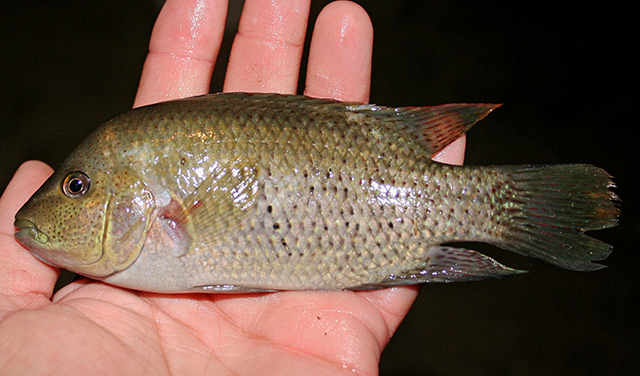| Cichlidae (Cichlids), subfamily: Cichlinae |
| 10.89 cm SL (male/unsexed) |
|
benthopelagic; freshwater; pH range: 7 - 8 |
| Central America: Laguna Azteca in the headwaters of the Rio Panuco of the Rio Moctezuma Basin, Mexico. |
|
Dorsal spines (total): 16-18; Dorsal soft rays (total): 10-11; Anal spines: 5-7; Anal soft rays: 8-10. Differs from other species by possessing a slender (slightly broader than long), well-spaced, and indented lower pharyngeal plate; 2 rows of 8-9 medium-sized, lightly pigmented molars flank the midline; and 11-13 non-enlarged conic teeth along the posterior margin. Distinguished from all congeners by a combination of the following characters: head short (mean 35%, SD 3%); rostral tip to the pectoral fin origin distance (mean 33%, SD 1%); caudal peduncle short (mean 15%, SD 1%) and deep (mean 16%, SD 1%); long anal fin (origin to hypural base distance; mean 40%, SD 1%); wide preorbit (mean 30%, SD 3%); eye small (mean 21%, SD 2%); predorsal contour deep and nonacute, which is not concave before the eye; and peritoneum is uniformly very dark (Ref. 94458). |
| Inhabits Laguna Azteca, characterized by a depth of 16 m, transparency of 1-3 m, surface temperatures of 16-27°C, and surface pH of 7-8. Does not occur sympatrically with other native cichlids. Feeds mainly on filamentous algae. Threatened by the introduction of tilapia and centrachids (Micropterus salmoides and Lepomis spp.) (Ref. 94458). |
|
Not Evaluated (N.E.) Ref. (130435)
|
| harmless |
Source and more info: www.fishbase.org. For personal, classroom, and other internal use only. Not for publication.
